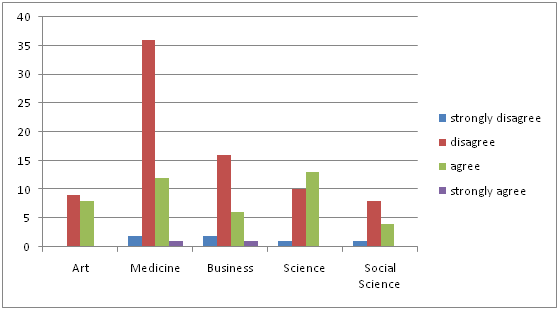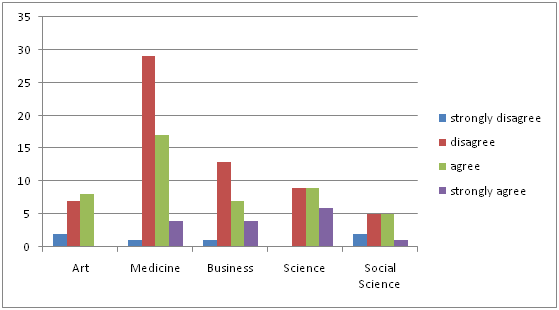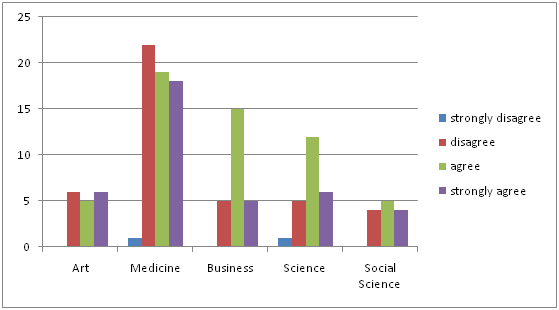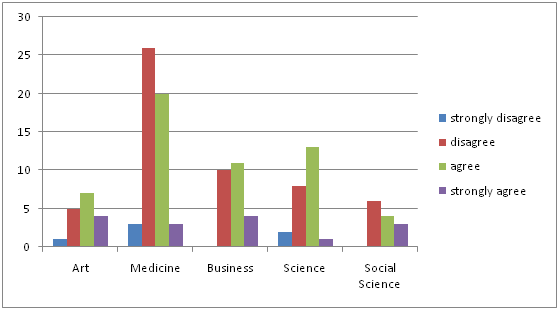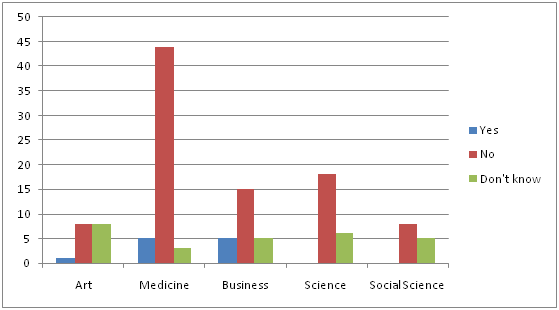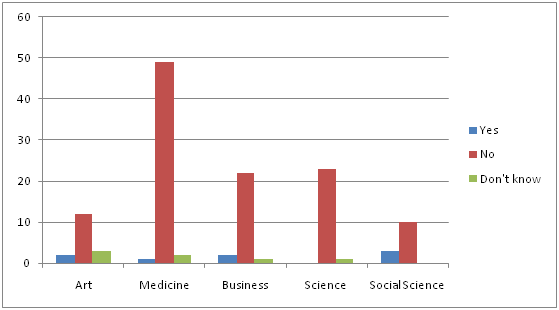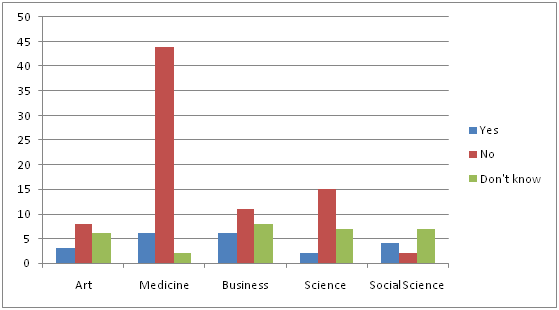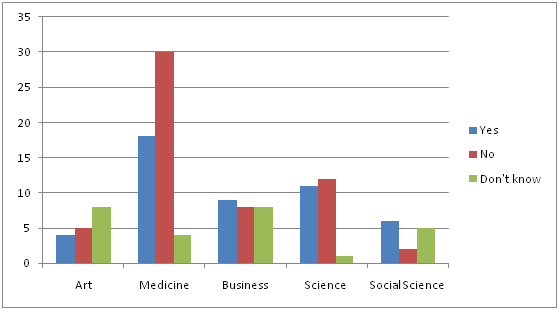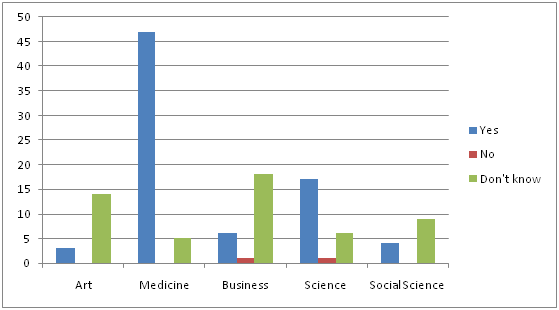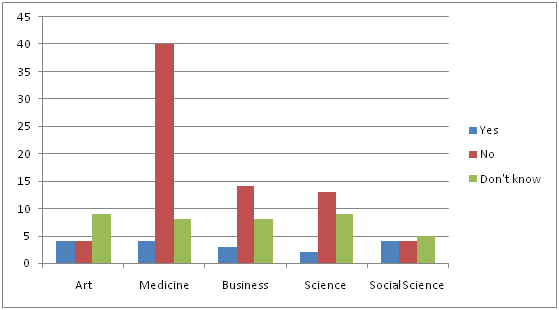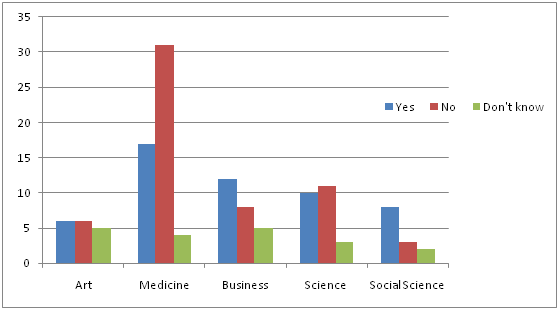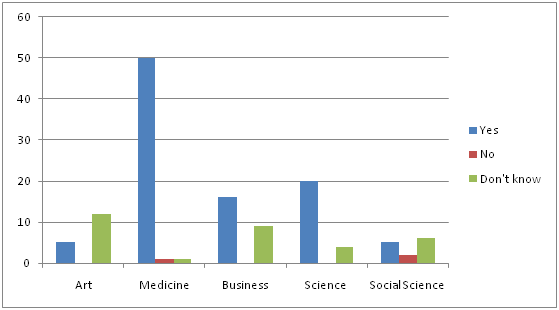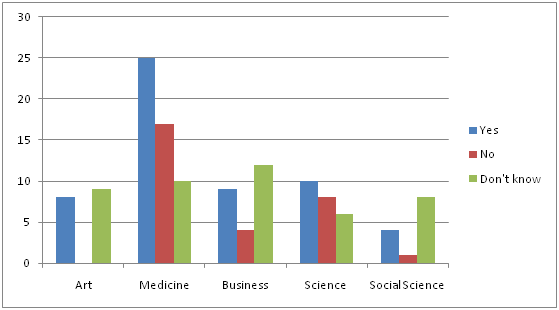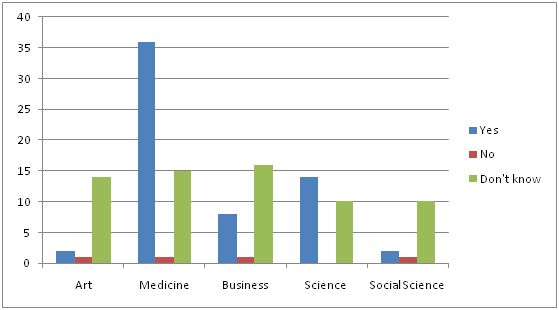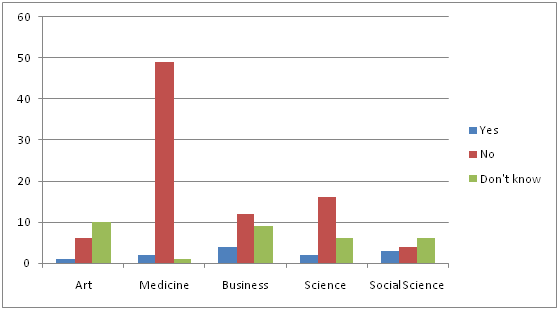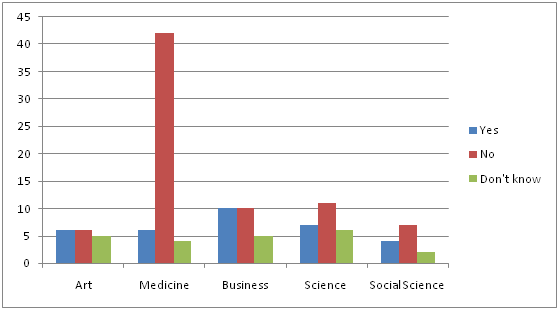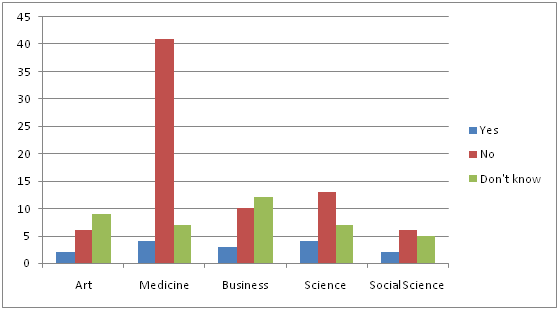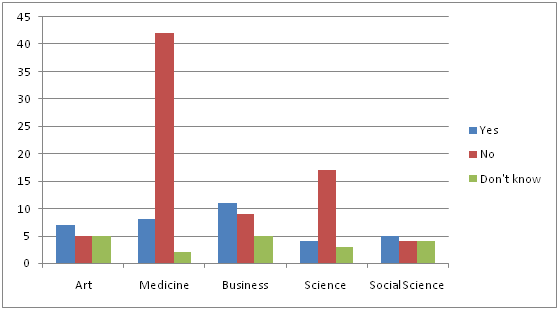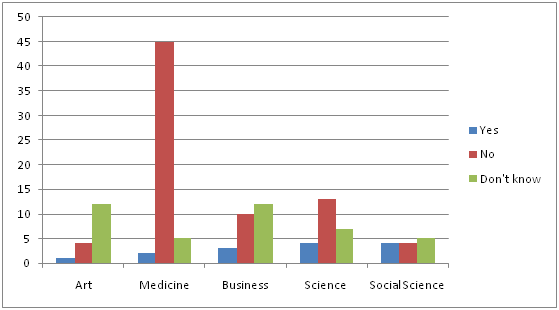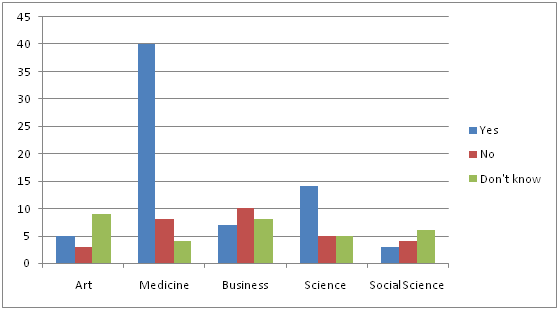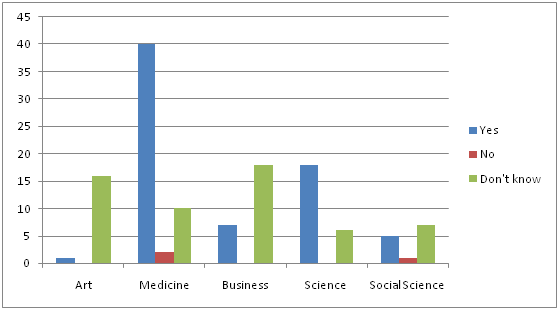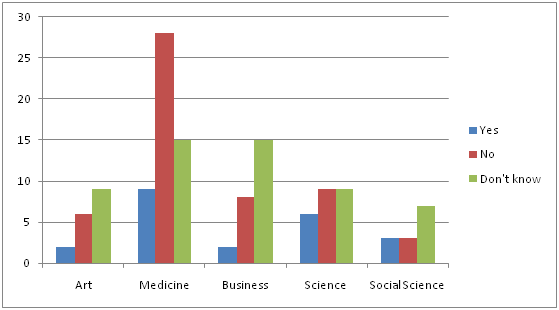Team:HKU-HKBU/human practice findings
From 2009.igem.org
YinanZhang (Talk | contribs) (New page: {{Team:HKU-HKBU/style.css}} {{Team:HKU-HKBU/script.js}} {{Team:HKU-HKBU/header}} =Division for Human Practices Advance - Findings= {{Team:HKU-HKBU/footer}}) |
YinanZhang (Talk | contribs) |
||
| Line 4: | Line 4: | ||
=Division for Human Practices Advance - Findings= | =Division for Human Practices Advance - Findings= | ||
| + | |||
| + | ===Attitude towards synthetic biology and related areas=== | ||
| + | # [[#Figure_1 | In contrast with students from other faculties, the majority of science students agree that Genetically Modified food is harmful.]] | ||
| + | # [[#Figure_2 | In contrast with students from other faculties, the majority of science students agree that genetically modified organisms should be retained in the laboratory setting and should never be released into the wild.]] | ||
| + | # [[#Figure_3 | The majority of all students agree that manipulating, inflicting trauma or killing primates (e.g. monkeys) for experimental purpose is morally wrong.]] | ||
| + | # [[#Figure_4 | In contrast with students from other faculties, the majority of medical students disagree that manipulating, inflicting trauma or killing mouse/guinea pig for experimental purpose is morally wrong.]] | ||
| + | |||
| + | ===Knowledge of synthetic biology and related areas=== | ||
| + | # Concepts that are well known to non-science, non medical students | ||
| + | #* [[#Figure_5 | Cell types are interchangeable, e.g. muscle cells can become blood cells?]] | ||
| + | #* [[#Figure_6 | If the parent of a child has a inherited disease, the child would have the same disease?]] | ||
| + | #* [[#Figure_7 | All infectious substances are living things?]] | ||
| + | # Concepts not well known to non-science, non-medical students | ||
| + | #* [[#Figure_8 | DNA only exist in the nuclei of cells?]] | ||
| + | #* [[#Figure_9 | One of the ways to introduce genes into a bacterium is to introduce a plasmid into it?]] | ||
| + | #* [[#Figure_10 | All bacteria are capable of locomotion?]] | ||
| + | #* [[#Figure_11 | Gene therapy has already been widely used in modern medicine?]] | ||
| + | #* [[#Figure_12 | DNA is made up of 4 types of bases: adenine (A), guanine (G), thymine (T) and cytosine (C)?]] | ||
| + | #* [[#Figure_13 | RNA can be genetically inheritable?]] | ||
| + | #* [[#Figure_14 | Green florescent protein allows the identification of protein expression?]] | ||
| + | #* [[#Figure_15 | Cells communicate with each other by electrical signals only?]] | ||
| + | #* [[#Figure_16 | Normal human cells have unlimited replication potential?]] | ||
| + | #* [[#Figure_17 | Bacteria cannot exchange their genes among themselves?]] | ||
| + | #* [[#Figure_18 | All mutations in DNA have effect(s) on the cell?]] | ||
| + | #* [[#Figure_19 | Virus replicate outside the cells.]] | ||
| + | #* [[#Figure_20 | The function of genes is to manufacture proteins?]] | ||
| + | #* [[#Figure_21 | In synthetic biology, the most commonly used organism is Escherichia coli?]] | ||
| + | # Concepts not well known to all students | ||
| + | #* [[#Figure_22 | Up to this moment, scientists have successfully synthesized an organism from molecules?]] | ||
| + | |||
| + | ==Figures== | ||
| + | |||
| + | ====Figure 1==== | ||
| + | Genetically modified food is harmful to the human body. | ||
| + | |||
| + | [[Image:HKU-HKBU_human_practice_findings_figure_1.png | center]] | ||
| + | |||
| + | Discussion: | ||
| + | |||
| + | The majority of science students question the safety of genetically modified food, while the majority of students from other faculties do not. In contrast, the majority of medical students (i.e. future health care professionals) do not. We could not think of a satisfactory explanation for this. | ||
| + | |||
| + | ====Figure 2==== | ||
| + | Genetically modified organisms should be retained in the laboratory setting and should never be released into the wild. | ||
| + | |||
| + | [[Image:HKU-HKBU_human_practice_findings_figure_2.png | center]] | ||
| + | |||
| + | Discussion: | ||
| + | |||
| + | The majority of science students are aware that releasing GM organisms into the wild may disturb the natural gene pool of the organism, which may then lead to ecological consequences. Students from other faculties are less aware of the consequences. | ||
| + | |||
| + | ====Figure 3==== | ||
| + | [[Image:HKU-HKBU_human_practice_findings_figure_3.png | center]] | ||
| + | |||
| + | ====Figure 4==== | ||
| + | [[Image:HKU-HKBU_human_practice_findings_figure_4.png | center]] | ||
| + | |||
| + | ====Figure 5==== | ||
| + | [[Image:HKU-HKBU_human_practice_findings_figure_5.png | center]] | ||
| + | |||
| + | ====Figure 6==== | ||
| + | [[Image:HKU-HKBU_human_practice_findings_figure_6.png | center]] | ||
| + | |||
| + | ====Figure 7==== | ||
| + | [[Image:HKU-HKBU_human_practice_findings_figure_7.png | center]] | ||
| + | |||
| + | ====Figure 8==== | ||
| + | [[Image:HKU-HKBU_human_practice_findings_figure_8.png | center]] | ||
| + | |||
| + | ====Figure 9==== | ||
| + | [[Image:HKU-HKBU_human_practice_findings_figure_9.png | center]] | ||
| + | |||
| + | ====Figure 10==== | ||
| + | [[Image:HKU-HKBU_human_practice_findings_figure_10.png | center]] | ||
| + | |||
| + | ====Figure 11==== | ||
| + | [[Image:HKU-HKBU_human_practice_findings_figure_11.png | center]] | ||
| + | |||
| + | ====Figure 12==== | ||
| + | [[Image:HKU-HKBU_human_practice_findings_figure_12.png | center]] | ||
| + | |||
| + | ====Figure 13==== | ||
| + | [[Image:HKU-HKBU_human_practice_findings_figure_13.png | center]] | ||
| + | |||
| + | ====Figure 14==== | ||
| + | [[Image:HKU-HKBU_human_practice_findings_figure_14.png | center]] | ||
| + | |||
| + | ====Figure 15==== | ||
| + | [[Image:HKU-HKBU_human_practice_findings_figure_15.png | center]] | ||
| + | |||
| + | ====Figure 16==== | ||
| + | [[Image:HKU-HKBU_human_practice_findings_figure_16.png | center]] | ||
| + | |||
| + | ====Figure 17==== | ||
| + | [[Image:HKU-HKBU_human_practice_findings_figure_17.png | center]] | ||
| + | |||
| + | ====Figure 18==== | ||
| + | [[Image:HKU-HKBU_human_practice_findings_figure_18.png | center]] | ||
| + | |||
| + | ====Figure 19==== | ||
| + | [[Image:HKU-HKBU_human_practice_findings_figure_19.png | center]] | ||
| + | |||
| + | ====Figure 20==== | ||
| + | [[Image:HKU-HKBU_human_practice_findings_figure_20.png | center]] | ||
| + | |||
| + | ====Figure 21==== | ||
| + | [[Image:HKU-HKBU_human_practice_findings_figure_21.png | center]] | ||
| + | |||
| + | ====Figure 22==== | ||
| + | [[Image:HKU-HKBU_human_practice_findings_figure_22.png | center]] | ||
| + | |||
{{Team:HKU-HKBU/footer}} | {{Team:HKU-HKBU/footer}} | ||
Revision as of 09:00, 14 October 2009
Division for Human Practices Advance - Findings
- In contrast with students from other faculties, the majority of science students agree that Genetically Modified food is harmful.
- In contrast with students from other faculties, the majority of science students agree that genetically modified organisms should be retained in the laboratory setting and should never be released into the wild.
- The majority of all students agree that manipulating, inflicting trauma or killing primates (e.g. monkeys) for experimental purpose is morally wrong.
- In contrast with students from other faculties, the majority of medical students disagree that manipulating, inflicting trauma or killing mouse/guinea pig for experimental purpose is morally wrong.
- Concepts that are well known to non-science, non medical students
- Concepts not well known to non-science, non-medical students
- DNA only exist in the nuclei of cells?
- One of the ways to introduce genes into a bacterium is to introduce a plasmid into it?
- All bacteria are capable of locomotion?
- Gene therapy has already been widely used in modern medicine?
- DNA is made up of 4 types of bases: adenine (A), guanine (G), thymine (T) and cytosine (C)?
- RNA can be genetically inheritable?
- Green florescent protein allows the identification of protein expression?
- Cells communicate with each other by electrical signals only?
- Normal human cells have unlimited replication potential?
- Bacteria cannot exchange their genes among themselves?
- All mutations in DNA have effect(s) on the cell?
- Virus replicate outside the cells.
- The function of genes is to manufacture proteins?
- In synthetic biology, the most commonly used organism is Escherichia coli?
- Concepts not well known to all students
Figures
Figure 1
Genetically modified food is harmful to the human body.
Discussion:
The majority of science students question the safety of genetically modified food, while the majority of students from other faculties do not. In contrast, the majority of medical students (i.e. future health care professionals) do not. We could not think of a satisfactory explanation for this.
Figure 2
Genetically modified organisms should be retained in the laboratory setting and should never be released into the wild.
Discussion:
The majority of science students are aware that releasing GM organisms into the wild may disturb the natural gene pool of the organism, which may then lead to ecological consequences. Students from other faculties are less aware of the consequences.
Figure 3
Figure 4
Figure 5
Figure 6
Figure 7
Figure 8
Figure 9
Figure 10
Figure 11
Figure 12
Figure 13
Figure 14
Figure 15
Figure 16
Figure 17
Figure 18
Figure 19
Figure 20
Figure 21
Figure 22
 "
"

